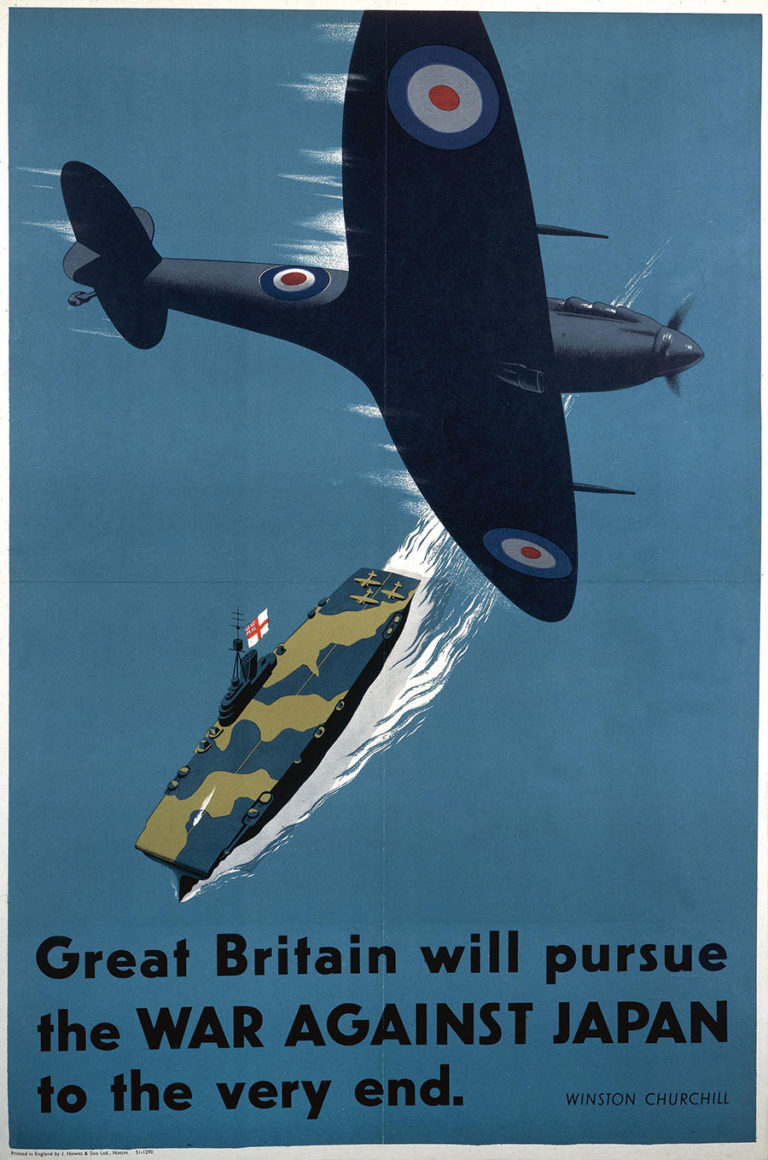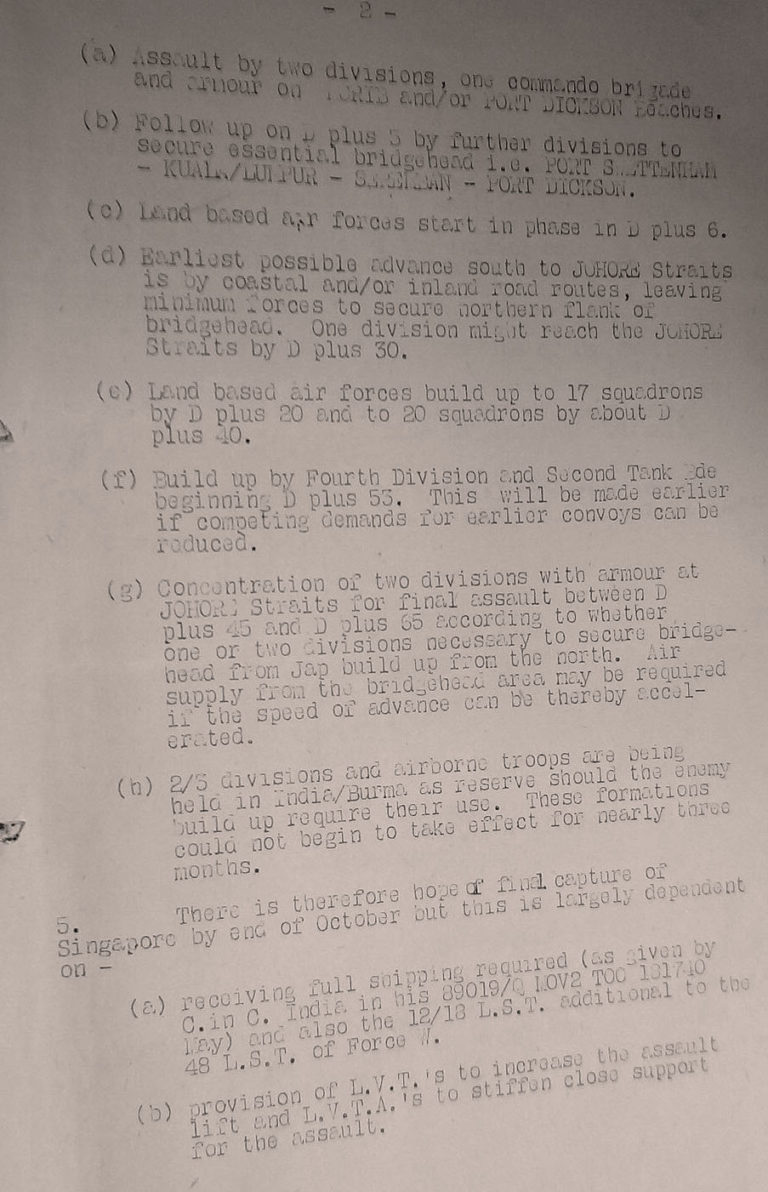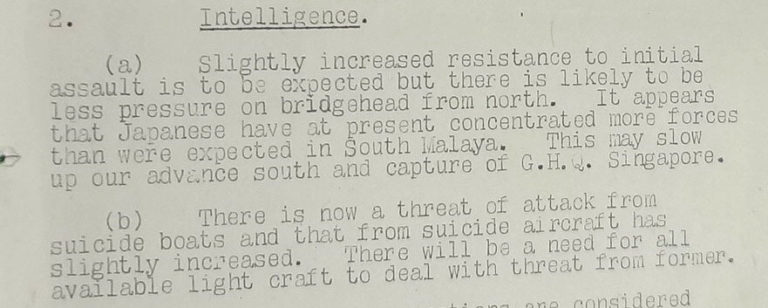In the week leading up to VE Day in 1945, British and Indian forces had succeeded in capturing the majority of Burma (modern-day Myanmar) and its capital Rangoon, without a fight, during Operations Capital and Dracula. Japanese forces had abandoned the city days before Allied forces arrived, meaning that only 24 casualties were suffered, all as a result of friendly fire.
The rapid success of these operations caused the Allied authorities to turn their attention to the swift capture of Malaya, the opening of the Straits of Malacca, and the capture of Singapore. Planners were informed on 4 May 1945 that ‘in view of the rapidly deteriorating Japanese position and the negligible Japanese naval and air threat’ it was proposed that Operation Zipper and Mailfist be launched during the second half of August to ‘accelerate the capture of Shackle’, which was the codename for Singapore (DEFE 2/648A). Records available at The National Archives reveal the scale of the planning which took place in preparation for these operations.

By the end of July 1945, planners correctly warned that with the fall of Rangoon, Japanese forces anticipated an early assault on Malaya itself and that Singapore was the ultimate objective, but were unsure as to which area was the most likely for an initial assault. They estimated that Japanese forces stood at 24 infantry battalions and 75 tanks in Malaya, a total of 59,000 troops. By the time of the commencement of Zipper, it could potentially rise to 72,000 troops. Planners called for the massing of the 5th, 23rd, 25th and 26th Indian Divisions, the 3rd Commando Brigade and one parachute brigade of the British 6th Airborne Division, totalling more than 100,000 troops (WO 203/4489).
These four Indian divisions had, in March 1945, been formed as the Indian XXIV Corps as part of the famous British Fourteenth Army. The latter three divisions above had all fought in the Burma campaign. The 5th Indian Division, however, had fought during the East African campaign in 1940/1941 and was heavily involved in the Western Desert campaign and the First Battle of El Alamein, before moving to take part in the fighting in Burma. As such, it was one of very few Allied divisions which could say that it had fought against Italian, German, and Japanese forces.
Elements of the British 6th Airborne had, of course, also landed on D-Day in June 1944, where it secured the left flank of the Allied invasion in Normandy. It had then also taken part in Operation Market Garden, the so-called ‘Bridge Too Far’, and had made its third combat air assault over the River Rhine in to Germany in March 1945.
Planning for the operation also occurred concurrently with that of Operation Downfall, the proposed invasion of mainland Japan, of which Britain wished to participate. It had been noted by British Chiefs of Staff, who had sought and obtained the approval of the United States to launch Zipper and Mailfist as long as operations did not interfere with Downfall, that the British priority would have to be the recapture of Singapore. Any British participation in the invasion of Japan, and with it the creation of a Commonwealth force, was on the condition that Malaya and Singapore were captured quickly (CAB 79/33).

The initial assault, as part of Operation Zipper, sought to secure an airfield located near Morib, and capture Port Swettenham (modern-day Port Klang), both situated near Kuala Lumpur in the middle of the western peninsula of Malaya. This was to be done by one division, while a second would immediately follow up with the object of clearing the road southwards. By D plus 3, another division, plus the Commando brigade would assault, with full naval support, the beaches south of Port Dickson, located to the south and halfway between Kuala Lumpur and Malacca.
Planners noted that a larger force than was expected had gathered in South Malaya, which they thought would slow down any advance. There was also a feeling that ‘there is now a threat of attack from suicide boats and that from suicide aircraft’. An estimation was made that between five and ten such attacks could be mounted each day. Naval vessels were in short supply, hence why the assault had to be slightly staggered, and this would ensure adequate naval air and gun support. The assault, however, was to be supported by over 500 aircraft from the Royal Air Force (DEFE 2/648A).

Once the bridgeheads had been secured, an advance south would occur by D plus 12, using one division with armour utilising the main inland and coastal roads. No firm plan had been devised for the assault and capture of Singapore. The hope was that forces could ‘jump the island’, assaulting from across the Johore Strait, with a force of two divisions, with additional support from commandos and the parachute brigade allotted to the operation. It was hoped that this element of the operation, codenamed Mailfist, could occur by December 1945.
‘D-Day’ for Operation Zipper had been pushed back to 9 September 1945 and it was, of course, cancelled as a result of the Japanese surrender in the middle of August. Instead, a version of the plan, Operation Tiderace, was launched during the first week of September, when British, Indian, Australian, and French naval forces set sail for the area. The fleet arrived in Singapore on 4 September and met no resistance. The formal surrender commenced on 12 September when Lord Louis Mountbatten, the Supreme Allied Commander of Southeast Asia Command, came to Singapore and accepted the surrender of the Japanese Southern Army Group.
The author of the blog says that ‘the British priority would have to be the recapture of Singapore [and] any British participation in the invasion of Japan, and with it the creation of a Commonwealth force, was on the condition that Malaya and Singapore were captured quickly’. I’d be interested in teasing out the reasons for that priority. Is there any further information available in the resources?
My father flew out to India after VE Day with 298 Squadron. My understanding is that there was an intention that they would be involved in glider assaults on the Japanese home islands. I have never seen any official plans for this and it may be that their role was primarily to be as part of the Zipper forces. Do you have any information on this?
What information does the National Archives hold on the initial advance party that landed on Singapore in the period after the Japanese emperor’s surrender broadcast on 15th August 1945? I was told by one of its members that it consisted of a small group of officers from Force 136 led by a brigadier who parachuted onto Kallang airfield after a lengthy flight from Kandy, Sri Lanka in a Liberator. It took some nerve because the Japanese had not responded to repeated British radio messages advising them of their intentions. Later the same day they were the first friendly troops to make contact with the prisoners at Changi.
My father landed at Morib Beach.
He was Reme, attached to the 23rd, he spent his time there bringing ashore the many vehicles. He went on to Siam (Thailand), Singapore, including (Changi)
and finally Hong Kong before returning home.
He did manage to return to Morib and all the other places he had visited
6th Airborne Division was not present at Operation Market Garden, that was the 1st Airborne Division
My father also landed at Morib beach as part of Operation Zipper. He was in the R.E.M.E. and worked on “waterproofing” vehicles before the landing, then getting the vehicles onshore. Difficult due to the nature of the beach some people died. He was in Thailand and Hong Kong after landing in Malaysia. Came home in 1947. He always said that they would have died in the Zipper landings if Japan had not been bombed and surrended.
My father PI Idiculas, Sapper, Queen Victoria’s Own Madras Sappers & Miners, Royal Indian Engineers landed in Morib, Selangor, Malaya on 9th September 1945.
After a brief period (mid-1946) in North Malaya his unit was posted to Bandung in Indonesia as part of the UN Peacekeeping force during the Indonesian Independence struggle against the Dutch. In August 1947, India got its independence. While the rest of the Indian troops were repatriated back to India either to be demobbed or to continue in the new Indian Army, his unit remained in Indonesia until 1948. He was one of the very few who was transferred to the post-war British Army to be stationed in Malaya and Singapore. He was transferred to the REME corps. He served in the Far East until the end of 1963.
He ten served in private sector in the engineering industry with UniLever Plantations, and Gammon Civil Engineering and with Union Oil 76 Inc. He had an amazing life and career; and died on Maundy Thursday in 1992 in Kuala Lumpur, Malaysia. A wonderful husband and father.
HIS BACKGROUND BEFORE OPERATION ZIPPER:
Borm in Quilon in the Kingdom of Tranvancore, Dad joined the British Indian Army in Wellington Barracks, Connoor in Nilgiri Hills, South India in 1938. He did his basic training in Nasik and was posted to the North West Frontier in Afghanistan. He was then sent to North Africa serving in the 8th Army under Montgomery fighting the Germans and Italians. After the defeat of Rommel, he was sent to Imphal in North Eastern India to fight the Japanese as part of the 14th Army under Slim. Then, on the ship to Mandalay in Burma gain to fight the Japanese.
In mid 1945, on completion of that deployment he was recalled to Bombay to get on a ship again for this Operation Zipper in September 1945.
~ J Idiculas, Sydney, Australia.
My father Michael O’Sullivan was an RAF medic in one of the landing craft that landed at Klang. One of the other landing craft capsized on a sandbank , he said, killing his RAF colleagues. Upon landing , amongst other civilians they liberated a group of imprisoned Irish nuns.
My father was a British lieutenant serving with the Indian 16th cavalary. He had been in Saigon where they had been supporting the French. On 12th January 1946 they departed from SAIGON TO Singapore. On 2 L S T naval ships with their 15cwt trucks and jeep etc
At sea for 3 and half days.
They were at Port Dickson Malaya.the ship landed and dropped back end to allow truck dive off. Second ship not so lucky and had to drive through the sea. They stayed at rubber plantation